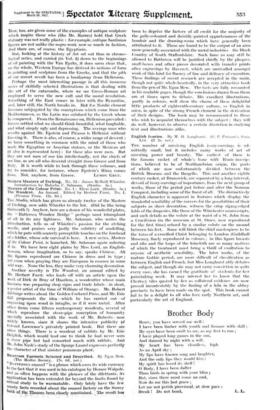Modern Masters of Etching. No. 13 : James McNeill Whistler.
(Fleuron Press. 12s. 6d.)
THE Studio, which has' given us already twelve of the Masters of Etching, now adds Whistler to the list. (Did he like being thirteenth ?) Anyhow, here are a dozen of his wonderful plates, the " Battersea Wooden Bridge " perhaps most triumphant of all in its airy lightness. Mr. Salaman, who writes the introduction, tells us of Whistler's passion for the etching needle, and praises very justly the subtlety of modelling, which he puts with scarcely perceptible touches on the forehead of a fiddler, whose sole survival is here. A new series, Masters of the Colour Print, is launched, Mr. Salaman again ushering it in. We have here eight plates by Miss Lord, an English- woman, whose imagination, so to say, speaks Chinese. All the figures reproduced are Chinese in dress and in type ; yet even when praying they are European in essence in some odd way. None the less, they make very charming decoration Another novelty is The Woodcut, an annual edited by Mr. Herbert Furst, who leads off with an article upon the work of Dirk de Bray of Haarlem, a woodcutter whose main business was preparing shop signs and trade labels—in short, a poster artist of the time of William of Orange. Mr. Robert Gibbings writes about the Golden Cockerel Press, and Mr. Eric Gill propounds the idea—which he has carried out—of engraving upon wood in intaglio, as if it were metal. After
other items come fifteen contemporary woodcuts, several of Welt reproduce the stove-pipe conception of humanity specially associated with the work of Mr. Roberts—now widely known, since it shares the intensive publicity of Colonel Lawrence's privately printed book. But there aim other things. There is a woodcut of rabbits by Mr. Eric
Dalglish, which would lead one to think he had never scum a stove pipe but had consorted much with rabbits. And Mr. John Nash's study of the Spurge Laurel expresses perfectly the character of that sinister poisonous plant.






















































 Previous page
Previous page